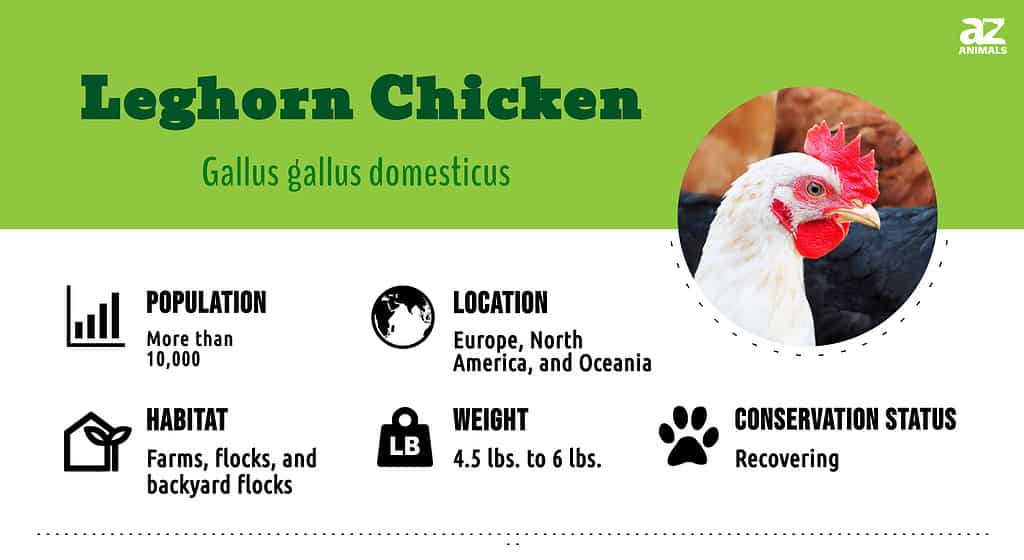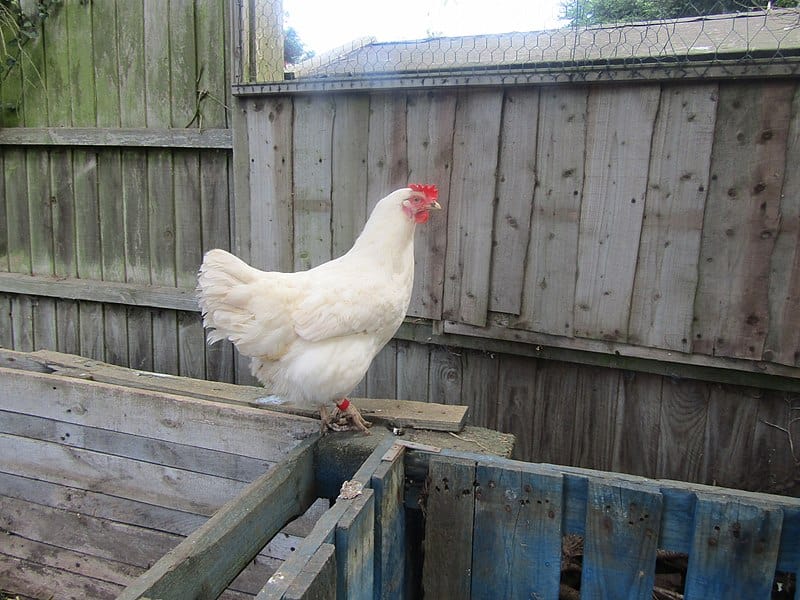
Backyard chicken raising is growing in popularity, so, understandably, new chicken owners want to know the leghorn chicken lifespan. This is especially true with leghorns being one of the most popular breeds for egg production throughout the U.S.
If you’re old school, the leghorn chicken conjures images of Foghorn Leghorn. ”I say, I say” Foghorn was one of the more interesting Looney Tunes characters in a cartoon flooded with colorful personalities. In reality, leghorns produce up to 320 eggs per year, which makes them one of the top egg layers in the country.
What Is The Leghorn Chicken Lifespan?
A leghorn chicken’s lifespan is roughly six years. They fall on the lower side of the 5 to 10-year average chicken lifespan. Those with experience raising chickens know that egg production typically drops off after three years, steadily decreasing each succeeding year.
Not only do leghorns lay a lot of eggs they are also capable of continuing to lay eggs well into their senior years, even if it’s at a drastically reduced level. If you own a leghorn chicken and take good care of it, it’s possible for it to survive for a full ten years, maybe longer.
A leghorn chicken lifespan is shorter than a lot of other backyard layers and farm chickens, but most chicken experts attribute that to their high level of egg production. It takes a good deal of energy and internal resources to develop and lay an egg, much less do so for almost every day of a single year. Even some hybrid leghorns out there are still highly productive.
Increase Leghorn Chicken Lifespan With Quality Of Life

Industrial leghorn chickens are white.
©Jay-Dee/Shutterstock.com
While nature will often take its course, regardless of attempts at intervention, there are some things you can do to improve the odds of a longer life for a leghorn chicken. One of the biggest health issues leghorns run into is simply wear and tear. They lay a lot of eggs, and it takes a toll on their bodies.
There’s very little a backyard chicken owner can do about this. On most farms, the leghorn becomes family dinner once egg production falls off significantly. What you can do is ensure that it has a nice, clean coop, plenty of water, plenty of food (to replenish all that lost energy), and a surrounding flock.
In other words, a pleasant and comfortable home. Leghorns aren’t susceptible to a ton of diseases outside what’s fairly normal on a farm or backyard operation. They’re hardy birds, able to contend with most of what life has to throw at them. They’re more susceptible to predation on open land, where birds of prey will happily drop from the sky for an afternoon snack.
Leghorns are prone to frostbite since they have a large wattle and comb. If you live up north, where freezes are more common, this is something you may have to contend with. Fresh water is critical. Always ensure there is fresh water available at any time. If your area experiences freeze you may need a heating source to be sure the water doesn’t freeze.
Other Leghorn Weaknesses
The leghorn chicken’s lifespan is shorter than many other chicken breeds, but it’s not the only drawback to the breed. They aren’t the most people-friendly of birds. If you own one, you probably know by now that leghorns tend to be flighty and nervous around people, unless you’re actively dumping chicken feed on the ground.
Like most chickens, a leghorn will overcome its anxiety if you’re feeding them. They are also fairly lightweight in the meat bird category. While no one considers them a viable meat bird for the market, they still make a decent chicken meal at home, after laying production drops off.
They aren’t very aggressive chickens, so they won’t pick fights very often. However, if you’re introducing a leghorn to an existing flock, they will most likely bully it for a while.
Leghorn Chicken Life Cycle

©The copyright holder of this file, Kolforn (Wikimedia), allows anyone to use it for any purpose, CC BY-SA 4.0, via Wikimedia Commons – License
The leghorn originally came from Italy, though people tend to associate it with Australia since it’s a verypopular bird there. They come in both regular and bantam variations, excluding hybrids and other mixed breeds.
After they hatch, leghorns mature rapidly, especially if they have plenty of protein in their starter food. At around four months, a leghorn will lay its first egg and will most likely celebrate it, like they will each one that comes after. They aren’t the most vocal of chickens out there, but they do tend to make a good deal of noise.
Their combs develop as quickly as three weeks, though you will have to wait a while longer to properly, visually determine the sex.
They will reach their full size between four and six months. They’re typically long and slender chickens and come in solid colors that include white, black, brown, silver, red, blue, and light brown. The leghorn chicken’s eggs are white, however, and between medium and large size.
Due to the shorter leghorn chicken lifespan, egg production will begin at three years, give or take a few months. Once the droop is noticeable, egg production will decrease by roughly 10% each succeeding year until the leghorn passes from old age.
Of course, there are always exceptions to the rule. The above life cycle is the average expectation from a leghorn chicken. However, as one of the most prolific egg layers available on the market, they will provide many eggs before they’re through.
Final Thoughts
The leghorn chicken lifespan is not as extensive as some other, popular egg layers out there. However, for the sheer number of eggs they lay, the trade-off is exceptional. Providing leghorns with a comfortable, safe, and resource-abundant environment will go a long way toward potentially extending their life, though there is no guarantee.
Predation is also an issue, depending on where the chickens are, and it’s especially bad if they are exposed to the air. In this case, a black leghorn is somewhat effective at warding off birds of prey. With only six years, enjoy it while it lasts, especially all those eggs. Keep your leghorn happy, and you may just get a year or two more.
The photo featured at the top of this post is © slowmotiongli/Shutterstock.com
Thank you for reading! Have some feedback for us? Contact the AZ Animals editorial team.






